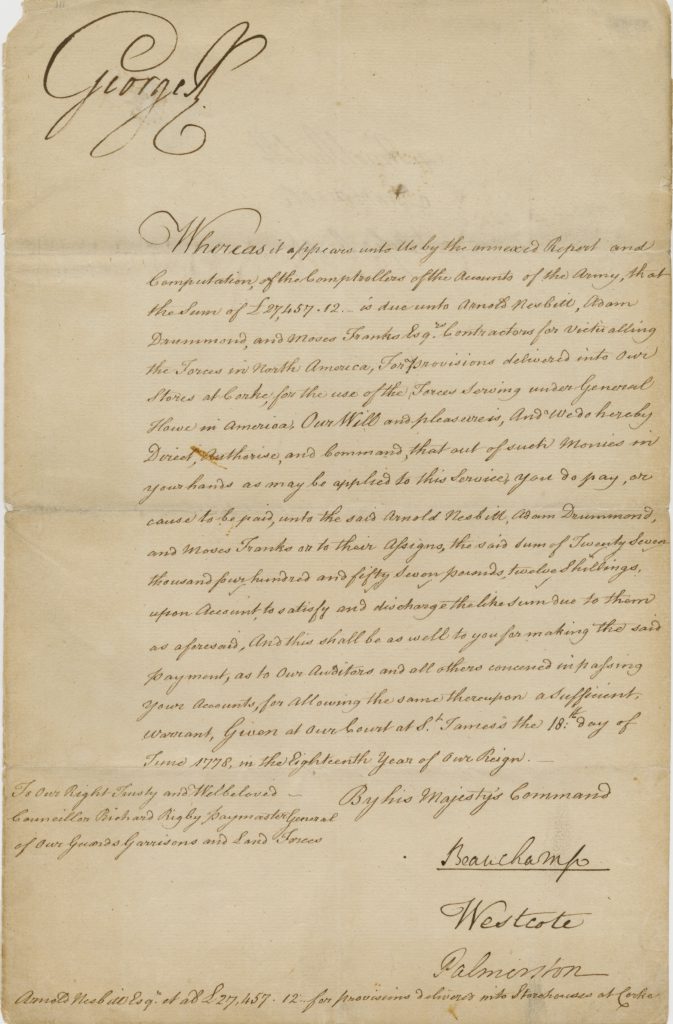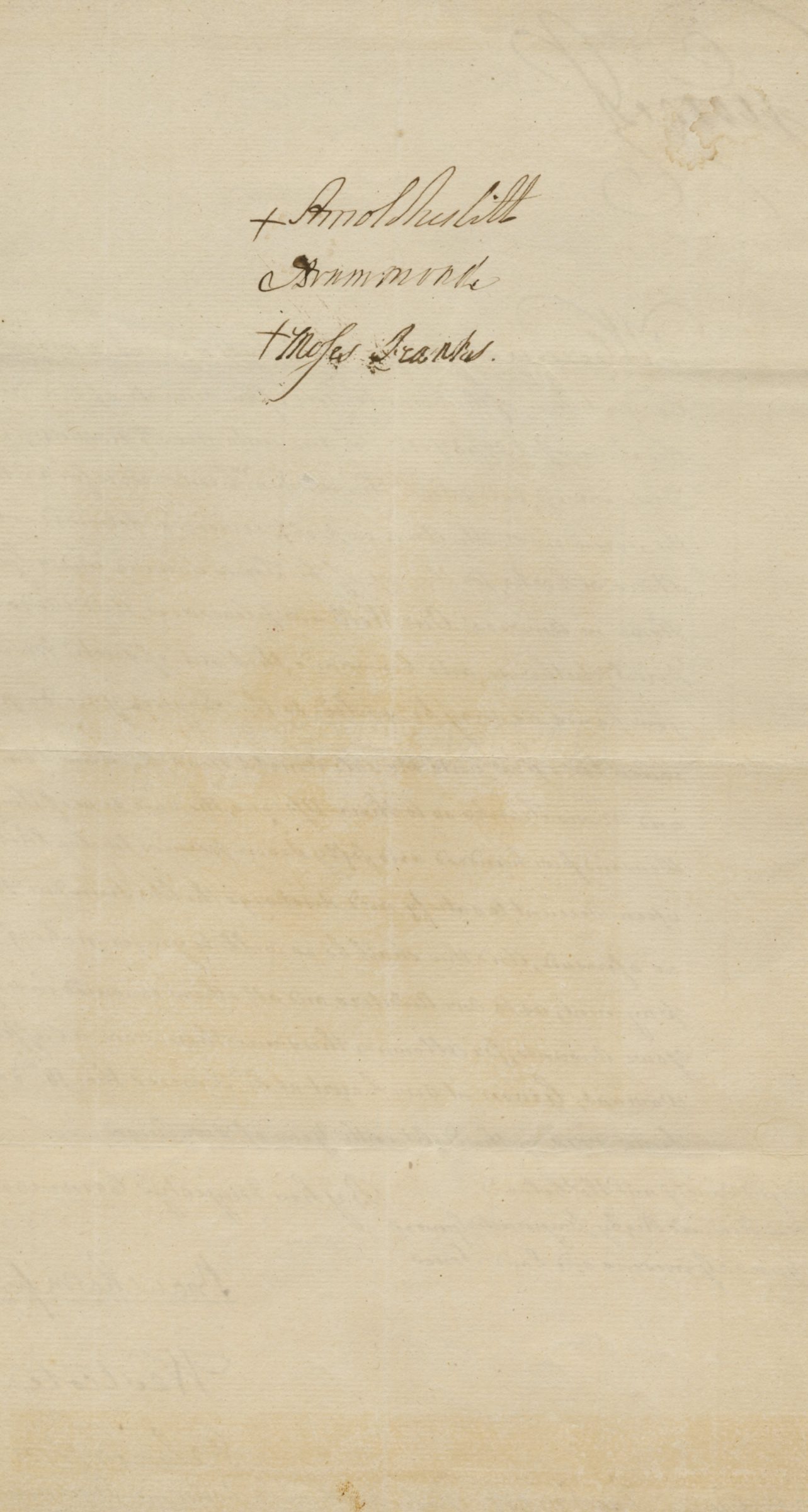King George III Finances His Efforts Against the Colonists in the American Revolution, Authorizing a Huge Expenditure to Supply His Forces Under Lord Howe





He authorizes over £27,457, a sum approximately equivalent to £50 million in today’s money
The document is signed on the verso by the merchant-suppliers, including Arnold Nesbitt, Adam Drummond, and Moses Franks, the latter being one of the most prominent Jewish loyalists in the American Revolution
Initially the British thought the American Revolution would be easily put down, at a nominal cost of men and money....
The document is signed on the verso by the merchant-suppliers, including Arnold Nesbitt, Adam Drummond, and Moses Franks, the latter being one of the most prominent Jewish loyalists in the American Revolution
Initially the British thought the American Revolution would be easily put down, at a nominal cost of men and money. This in large part explains their intransigence, both in the lead up to the war and in the early years of the conflict. But whereas 1776 saw major British victories and it seemed the Revolution might be played out, 1777 was an altogether different story. On Christmas 1776 George Washington and his Continental Army crossed the Delaware and scored a morale-boosting victory at Trenton, and this was very soon followed by another at Princeton. Then, on October 17, 1777, 5,895 British and Hessian troops surrendered their arms in a staggering American victory at Saratoga, foiling British plans to split the northern states from the rest of the country. British General John Burgoyne lost 86 percent of his expeditionary force. This event was big news in France, a traditional enemy of Britain, and the French now gained confidence in the American cause and chose to enter the war as an American ally. This would, in the end, make all the difference.
So by 1778 the cost to Britain of the Revolution was growing and the conflict was spreading. In February 1778 a Franco-American Treaty of Amity and Commerce was signed in Paris, and on March 13 the French minister in London informed King George III’s government that France officially recognized the United States. Three days later, on March 16, 1778, a peace commission was created by the British Parliament to negotiate with the Americans. The commissioners traveled to Philadelphia where they offered to grant all of the American demands, except independence. The British concessions were rejected by Congress. By June 1778, France entered the war as a military ally of the United States and was at war with Great Britain. No longer a confined revolution, the North American conflict became an international war. And an expensive one.
The British government had to supply and feed some 45,000 troops in America at the height of the war, about half of whom were British and half a combination of foreigners like Hessians and American loyalists. The Comptroller of Army Accounts, Thomas Bowlby, prepared and signed a report for the King and Government on June 11, 1778, concerning “Two certificates for provisions delivered in His Majesty’s storehouses…by Arnold Nesbitt, Adam Drummond, and Moses Franks, Esq., contractors for delivering provisions there for 12,0000 of His Majesty’s forces serving in America. Which certificates Your Lordships are pleased to direct the Comptroller of the Accounts of the Army to consider & return with their report thereupon…I have considered the same…” The agent for the contractors specified that the two orders totaled over a million pounds of pork, about 274,000 pounds of beef, and close to 100,000 pounds of butter. “Which provisions,” writes the Comptroller, “are certified to have been properly packed in good, wholesome, sound condition fit for His Majesty’s service.” The Comptroller states that the sum due was £27,457 12s 1/2d, “The payment of which is humbly submitted to your Lordships to be made…” That sum is approximately equivalent to £50 million in today’s money.
The King and Government approved the expenditure. Document signed London, June 18, 1778, giving royal assent to the payment of 27,457 12s 1/2d to be paid to Arnold Nesbitt, Adam Drummond, and Moses Franks, “contractors for victualizing the forces in North America for provisions delivered…for the use of the forces serving under General Howe in America. Our Will and pleasure is, and we do hereby direct, authorize, and command…you do pay, or cause to be paid, unto the said Arnold Nesbitt, Adam Drummond, and Moses Franks…the said sum…” The document is countersigned by Lord Westcote and Viscount Beauchamp, Commissioners for the Office of Lord High Treasurer of England, and the Lord of the Treasury, Henry Temple, 2nd Viscount Palmerston. The document is signed on the verso by Nesbitt, Drummond, and Franks. Howe was commander-in-chief of British forces in America at this time. This document comes with the comptroller’s accounting.
Documents signed by King George III financing the American Revolution, or dealing directly with it in any way, are very uncommon, this being our first. A search of public sale records indicates it has been over twenty years since another document such as this reached that marketplace.
By 1770, Britons Arnold Nesbitt, a member of Parliament, and Adam Drummond, were in partnership holding contracts for victualing British troops in North America and Canada. After the outbreak of the American War, the size of the contracts was doubled.
A branch of the Franks family in America were merchants, and they were the most prominent Jewish Loyalists in the American Revolution. The father, Jacob Franks, was from New York. There were two brothers. Moses Franks was living in London as representative there, and David Franks was based in Philadelphia, until he fled to England during the war. Their firm had supplied the British troops as a co-contractor with, and fulfilled contractual requirements passed on from, the firm of Arnold Nesbitt and Adam Drummond. This business arrangement had been in force since the conclusion of the French and Indian War, and continued through the American Revolution. Another branch of the Franks family were strong patriots in the Revolution. One, also named David, was an aide to George Washington, and Rachel, daughter of another Moses Franks, married Haym Salomon who helped finance the war.

Frame, Display, Preserve
Each frame is custom constructed, using only proper museum archival materials. This includes:The finest frames, tailored to match the document you have chosen. These can period style, antiqued, gilded, wood, etc. Fabric mats, including silk and satin, as well as museum mat board with hand painted bevels. Attachment of the document to the matting to ensure its protection. This "hinging" is done according to archival standards. Protective "glass," or Tru Vue Optium Acrylic glazing, which is shatter resistant, 99% UV protective, and anti-reflective. You benefit from our decades of experience in designing and creating beautiful, compelling, and protective framed historical documents.
Learn more about our Framing Services












































































































